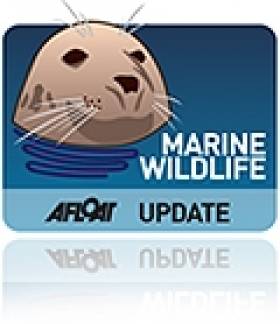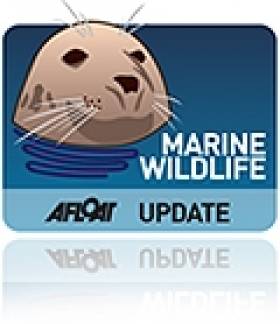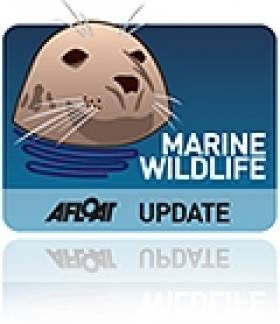Displaying items by tag: marine wildlife
Invasive Sea Squirt May Be in Strangford Lough
#MARINE WILDLIFE - The Northern Ireland Environmental Agency (NIEA) has indicated the possible presence of Japanese sea squirt on the bed of Strangford Lough, as the Press Associaton reports.
Experts are attemping to confirm the identity of the invasive organism that has posed a threat to mussel and scallop populations across the Irish Sea in north Wales.
The sea creature, Didemnum vexillum, spreads like a blanket across the seabed and other surfaces, smothering shellfish and other marine life in the process. It is often transported over large distances on boat hulls and fishing equipment.
It was discovered late last year in Holyhead marina, and Welsh athorities spent £250,000 on an extermination project to prevent its spread into the Menai Strait - at the heart of the region's shellfish industry.
Dr Rohan Holt, a senior scientist from the Countryside Council for Wales, has now been called in to advise on how to manage the threat should it indeed be confirmed as the Japanese sea quirt.
Meanwhile, members of the public have been urged to report any possible sightings of Japanese sea squirt with photos through the 'Alien Watch' section of the Invasive Species Ireland website.
The Press Association has more on the story HERE.
Portuguese Man-of-Wars Arrive on Irish Shores
#WATER SAFETY - Irish Water Safety is warning members of the public that Portuguese Man-of-Wars have landed on beaches in Waterford and Cork, with reports of sightings in Tramore, Ardmore, Inchydoney and Schull so far – and may land on other shores, particularly Kerry
With another sunny weekend expected, surfers and families enjoying the beach are at a high risk of encountering them and their stings, which usually cause severe pain to humans.
The Portuguese Man-of-War is an invertebrate and carnivore with tentacles that can reach up to 50 metres in length. Despite being commonly thought to be a jellyfish, it is actually a different form of marine wildlife known as a siphonophore: an animal made up of a colony of organisms working together.
Man-of-wars are sometimes found in groups of 1,000 or more, floating in warm waters throughout the world's oceans. They have no independent means of propulsion and either drift on the currents or catch the wind with their gas-filled floats. To avoid threats on the surface, they can deflate their air bags and briefly submerge.
They are most commonly found in the tropical and subtropical regions of the Pacific and Indian oceans and in the northern Atlantic Gulf Stream.
The stinging, venom-filled nematocysts in their tentacles are used to paralyse small fish and other prey. Stings leave whip-like, red welts on the skin that normally last two or three days after the initial sting, though the pain should subside after about an hour.
However, the venom can sometimes travel to the lymph nodes and may cause a more intense pain. A sting can also lead to an allergic reaction and other serious effects, including fever, shock, and interference with heart and lung function. Stings in some cases have been known to cause death, although this is extremely rare.
Medical attention may be necessary, especially if pain persists or is intense, there is an extreme reaction, the rash worsens, a feeling of overall illness develops, a red streak develops between swollen lymph nodes and the sting, or either area becomes red, warm and tender.
Even detached tentacles and dead specimens (including those that wash up on shore) can sting just as painfully as the live creature in the water and may remain potent for hours or even days after the death of the creature or the detachment of the tentacle, so should always be avoided.
The best treatment for a Portuguese Man-of-War sting is to avoid any further contact with the creature, carefully remove any remnants of it from the skin (taking care not to touch them directly with fingers or any other part of the skin to avoid secondary stinging), Apply salt water to the affected area (not fresh water, which tends to make the affected area worse) then follow up with the application of hot water (around 45 degrees C) to the affected area, which eases the pain of a sting by denaturing the toxins.
If eyes have been affected, to irrigate with copious amounts of room temperature tap water for at least 15 minutes, and if vision blurs or the eyes continue to tear, hurt, swell, or show light sensitivity after irrigating, or there is any concern, to see a doctor as soon as possible.
Vinegar is not recommended for treating stings, as it can increase toxin delivery and worsens symptoms of stings from this species. Vinegar has also been confirmed to provoke hemorrhaging when used on the less severe stings of nematocysts of smaller species.
For more details from Irish Water Safety on dealing with jellyfish stings, click HERE.
Blue Whales Spotted Off Kerry Coast in Ireland's Third Ever Sighting
#MARINE WILDLIFE - Members of the Irish Whale and Dolphin Group (IWDG) encountered the world's largest animals off the southwest coast of Ireland last Thursday.
Two blue whales were witnessed by the team on board the Celtic Mist near the edge of the continental shelf on the Porcupine Blight, west of Dursey Island in Co Kerry.
The marine giants - last recorded in Irish waters back in 2008 - reportedly surfaced within 500 metres of the boat.
Mission co-ordinator Patrick Lyne told The Irish Times that there may even have been three whales in the pod, as three blows of seawater were witnessed in a short space of time.
He also noted that the sighting was very significant as there are estimated to be fewer than 4,000 blue whales in the entire northern hemisphere - their numbers reduced drastically by whaling over the past hundred years.
At an average of 30 metres in lengh and an incredible 180 metric tins in weight, the blue whale is the largest animal to have ever lived on earth.
The Celtic Mist was on its maiden voyage as a research vessel for the IWDG, following its gifting to the group for marine wildlife conservation work by the Haughey family last year, and subsequent major refitting works.
The vessel set sail on Monday 3 Septmeber on a marine mammal observation and passive acoustic monitoring week, carrying a towed hydrophone array for acoustic detections below the surface.
During the weeklong mission the team on board enountered 11 different cetacean species including harbour porpoises, common dolphins, minke whales and a humpback whale.
Link to Blue Whales Spotted During an Air Corps Maritime Patrol
Divers Meet Dusty the Doolin Dolphin
#MARINE WILDLIFE - A hat-tip goes to WorldIrish for this video posted on Vimeo by Monty Cantson capturing the moment when a playful dolphin paid a visit to a group of divers in Bones Bay at Doolin, Co Clare recently.
According to Lahinch Surf Experience, the bottlenose dolphin goes by the name of Dusty, after the singer Dusty Springfield.
The female cetacean has been a fixture of the area for more than a decade, and while apparently less friendly than Dingle's famous Fungie - she doesn't like to be touched - she seems happy to swim beside swimmers and divers, and loves to play with anything you might have in the water with you!
16 Pilot Whales Die in Scotland Mass Stranding
#MARINE WILDLIFE - Marine wildlife experts are investigaing the causes of a mass stranding of pilot whales at Fife in eastern Scotland at the weekend.
The Press Association reports that 16 whales from a 26-strong group died when they stranded on a beach near St Andrews on the morning of Sunday 2 September. Three of those that died were calves.
More than 50 volunteers assisted members of the RNLI and vets from British Divers Marine Life Rescue (BDMLR) in refloating the other 10 whales at high tide yesterday afternoon, in what BDMLR co-ordinator Ali Jack described as "a fantastic effort".
Rescuers used specialist pontoons brought in from across Scotland as well as Newcastle and Cumbria in northern England.
According to The Guardian, some 24 whales from the same pod were spotted in the shallows further along the coast at Cellardyke and are under close observation.
A Forth coastguard spokesman said that vets would return to the beach this morning to carry out post-mortems on the whale carcasses to find any indication of what might have caused them to come so close to the shore.
The spokesman told The Guardian: "It is a very rare occurrence in Scotland and very sad. The usual scenario would be that the whale that is leading the group has become ill, or has lost its way, and gets beached and the rest will follow on, although we do not know for sure if that is what happened."
The incident brings back memories of last year's mass stranding of 44 pilot whales in the Scottish Highlands, as previously reported on Afloat.ie.
Twenty-five whales from that pod died at the Kyle of Durness, in a tragedy that mirrored the deaths of 33 whales in a similar mass beaching in Donegal in late 2010.
Graduates to Learn About Marine Conservation in the Irish Sea
#MARINE WILDLIFE - The News & Star reports that four graduate students have joined an 11-month scheme run by the Cumbria Wildlife Trust to learn more about marine conservation in the Irish Sea.
The programme, which includes classes and on-the-job training, will see them work at the South Walney Nature Reserve near Barrow-in-Furness, which is designatied as a Site of Specific Scientific Intrest, a Special Area of Conservation and a Special Protection Area.
“The graduates will play a pivotal role in helping people to understand and value the wildlife that exists in the Irish Sea and what role they can play in both protecting and enjoying it," said programme manager Emily Baxter.
Late last year, the find of a rare leatherback turtle washed up in Cumbria was taken as a sign that the Irish Sea is hiding an unknown bounty of marine wildlife, and reinforced calls for the region to be designanted as a Marine Conservation Zone.
Whale Watch Ireland Produces Good Sightings Despite Poor Weather
#MARINE WILDLIFE - Loop Head in Clare was certainly the place to be for the annual Whale Watch Ireland on Sunday 19 August, with dolphins and two species of whale spotted despite the poor weather.
According to the Irish Whale and Dolphin Group (IWDG), which organised the national event in conjunction with National Heritage Week to promote consevation of Ireland's marine wildlife, some 80 whale watchers and curious beginners spotted 11 bottlenose dolphins, a minke whale and a large baleen whale species - the only whales seen on the day among the 16 organised coastal watches.
Overall sightings were good, even with the unfavourable conditions experienced at half the viewing sites, and which saw the event at Baginbun Head on the Hook Peninsula in Co Wexford sadly cancelled.
In total, cetateans were seen at 10 of the 16 sites, which is up on the 54% viewing rate recorded at last year's national whale watch.
The biggest attended sites this year were Killiney Bay in Dublin, where three harbour porpoises were seen by 100 viewers; Galley Head in Cork, where six porpoises were witnessed in adverse weather that still brought out 120 eager cetation spotters.
Dolphins and porpoise together entertained the modest crowds at Howth head in north Dublin, St John's Point in Donegal and Bloody Bridge in Co Down, while the biggest count of bottlenose dolphins apart from Loop Head was the 10 recorded at Portmuck in Antrim.
Harbour Porpoises Get Protection With New NI Marine Zones
#MARINE WILDLIFE - Protection for harbour porpoise off the north coast of Northern Ireland has been assured by the creation of two new areas of marine protection, as BBC News reports.
The new Special Areas of Conservation off Co Antrim encompass the sea and seabed surrounding the Maidens in the North Channel off Larne - protecting reefs and grey seals - and spots adjacent to the Giant's Causeway and Portrush Skerries in the north of the county.
Both areas are also considered of great importance to harbour porpoises, and according to Environment Minister Alex Attwood, the designation "comfirms that their numbers are significant throughout the year".
He added: "I hope this encourages people to visit the area to get a glimpse of these beautiful animals."
Campaigners are hoping for further coastal protections to be guaranteed by the Marine Bill, which will be debated at Stormont ths Autumn.
As reported earlier this year on Afloat.ie, the Northern Ireland Marine Task Force brought togethter politicians, environmentalists, fishermen and wind farm developers to ensure the new bill will deliver for all sea users.
Dancing Dolphins Surprise Researchers Off Donegal
#MARINE WILDLIFE - Marine researchers off the coast of Donegal were recently treated to a rare dolphin dance by a 50-strong pod, as IrishCentral reports.
The video above captures the same pod witnessed by researchers with the Irish Basking Shark Project, who were in the area off Inishowen to observe basking sharks in the coastal waters when they were surprised by the gregarious dolphin congregation.
A spokesperson for the project confirmed to IrishCentral that such large groupings of dolphins are unusual for the area, which has welcomed more than its fair share of large marine wildlife over recent months.
As previously reported on Afloat.ie, one of the first confirmed sightings of killer whales on the Irish coastline was recorded earlier this summer when a family of orcas from the Scottish Hebrides visited the same waters at the mouth of Lough Swilly.
Meanwhile, WorldIrish reports on the heartwarming tale of a Dutch couple who have bonded with Dingle's most famous non-human resident, Fungie the dolphin.
Jeannine Masset and Rudi Schamhart, who now live in Annascaul, have visited the friendly cetacean for 21 years, and their connection has inspired a fanpage on Facebook that has received responses from Fungie fans around the world.
"Fungie has enriched our lives and we want to give something back to him by offering our friendship and companionship to him," said Jeannine, "and he lets us know over and over again that he really appreciates it."
Samples Taken from Baltimore Fin Whale Carcass
#MARINE WILDLIFE - The Irish Examiner reports that samples from the fin whale that stranded and died in Baltimore Harbour last week have been sent to Dublin for analysis.
Samples of skin and blubber will be tested by marine science experts at the Irish Cetacean Tissue Bank in the Natural History Museum as well as at the Marine Institute, while a student studying for a PhD on the feeding ecology of fin whales will also examine the remains.
As reported yesterday on Afloat.ie, the whale carcass has been towed out of the inner harbour as preparations are made to sink it to the seabed, where marine life such as fish and crabs will quickly strip it down to a skeleton that locals hope to put on display in the West Cork town.
A post-mortem will not be carried out by the Irish Whale and Dolphin Group (IWDG) due to lack of funding for the specialised procedure. A previous necropsy of a fin whale stranded at Courtmacsherry was funded by the US-based magazine National Geographic.






































































